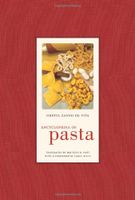Advertisement
Cuscus
Unusual shape
Published 2009
The cuscus is then steamed for a long time in a pignata, a specially designed terra-cotta pot with a bottom perforated with holes like a colander. This pot is placed on top of a second pot of the same diameter, and the join is sealed with a flour-and-water dough called cuddura, to keep steam from escaping. Liquid is boiled in the lower pot and the steam swells and cooks the cuscus in the upper pot. Today, a modern metal cuscussiera, or couscousière, is used, with two parts that fit together perfectly, so no sealing dough is needed.


